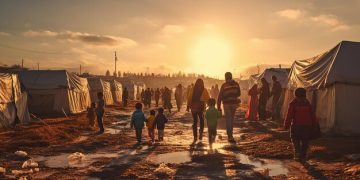US Response to Europe’s Refugee Crisis: A Comprehensive Look

The United States faces complex diplomatic, economic, and humanitarian considerations as it shapes its response to the evolving refugee crisis in Europe, necessitating a multi-faceted approach.
The escalating humanitarian challenges emanating from Europe’s ongoing refugee crisis demand a nuanced and robust international response. One prominent question emerges: How will the US respond to the growing refugee crisis in Europe? This inquiry delves into the intricate weave of policy, diplomacy, and humanitarian aid that defines America’s role on the global stage amidst unprecedented displacement.
Understanding the European Refugee Crisis: A Complex Tapestry
The current refugee crisis in Europe is not a singular event but a confluence of geopolitical instability, protracted conflicts, and socioeconomic disparities. Millions have been forced from their homes due to war, persecution, and climate change, seeking asylum and a better life within European borders. This influx places immense pressure on host nations, challenging their social structures, economic capacities, and political cohesion.
Understanding the layers of this crisis is paramount for comprehending the potential US responses. It’s not merely a matter of numbers but of human lives, each with a unique story of struggle and hope. The primary drivers include conflicts in the Middle East and Africa, such as the Syrian civil war, political instability in Afghanistan, and humanitarian crises in various Sub-Saharan African nations. These factors create a continuous flow of people seeking refuge, often through perilous journeys across land and sea.
The Scale and Scope of Displacement
The sheer volume of displaced individuals is staggering, with millions internally displaced and millions more seeking refuge across international borders. European nations, particularly those on the frontline like Greece, Italy, and later Germany and Sweden, have borne the brunt of this influx. Their asylum systems are often overwhelmed, leading to backlogs, inadequate living conditions, and increased social tensions.
- The UN Refugee Agency (UNHCR) reports record numbers of forcibly displaced people globally.
- Asylum applications in Europe have consistently remained high, stressing national resources.
- Economic disparities and opportunities often influence refugees’ destination choices within Europe.
The long-term integration of refugees also presents significant challenges, including language barriers, cultural differences, and access to fair employment opportunities. These integration hurdles can exacerbate social fragmentation and fuel anti-immigrant sentiments in some segments of the population. The response from different European Union member states has been varied, reflecting their individual capacities, political ideologies, and historical contexts.
Ultimately, the European refugee crisis is a multifaceted challenge that transcends national borders, requiring a coordinated and empathetic global response. The US, with its significant resources and global influence, is uniquely positioned to play a pivotal role in this complex humanitarian endeavor.
US Foreign Policy and Humanitarian Principles
The United States’ approach to international crises is typically guided by a blend of foreign policy objectives and humanitarian principles. When considering the European refugee crisis, this involves assessing national security interests, upholding democratic values, and responding to moral imperatives. The US often views global stability as directly linked to its own economic and security well-being.
Historically, the US has been a leader in humanitarian aid and refugee resettlement efforts. However, domestic political climates and evolving global dynamics can significantly influence the extent and nature of its involvement. The focus often shifts between direct aid, diplomatic pressure, and multilateral cooperation, all aimed at mitigating the crisis’s impact and addressing its root causes.
Balancing Interests and Values
The US government must consistently weigh its strategic interests against its stated humanitarian values. Providing aid and support to Europe in managing the refugee crisis can strengthen transatlantic alliances, project soft power, and potentially prevent further destabilization that could have broader global implications. Conversely, domestic concerns about immigration and resource allocation can sometimes temper the enthusiasm for extensive international intervention.
- Strategic alliances: Supporting Europe reinforces transatlantic bonds and shared democratic values.
- Economic stability: Addressing the crisis can prevent economic fallout that might impact global markets.
- Moral obligation: Adhering to international conventions and humanitarian commitments is a cornerstone.
The internal political discourse in the US heavily influences the administration’s capacity and willingness to engage substantially in refugee matters abroad. Public opinion, budgetary constraints, and the priorities of the executive branch all play a role in shaping the final policy response. The delicate balance between these factors often determines the speed and scale of US action.
In essence, the US response reflects a complex interplay of pragmatic foreign policy calculations and an underlying commitment to certain universal human rights and humanitarian principles, seeking to achieve both stability abroad and alignment with its national identity.
Channels of US Engagement: Aid, Diplomacy, and Resettlement
The US response to the European refugee crisis is typically multifaceted, employing various channels to address the complex situation. These channels include providing substantial financial and material aid, engaging in diplomatic initiatives, and participating in global refugee resettlement programs. Each avenue plays a distinct yet interconnected role in alleviating suffering and fostering long-term solutions.
Financial aid often targets UNHCR and other international organizations working directly on the ground in refugee camps and transit zones. This funding helps provide essentials like food, shelter, medical care, and education. Diplomatic efforts involve working with European allies to coordinate responses, share best practices, and address the root causes of displacement through political means. Resettlement, while a smaller part of the overall picture, offers a lifeline to some of the most vulnerable refugees.
Direct Financial and Material Aid
The United States is historically the largest donor of humanitarian aid globally. This aid is channeled through various multilateral organizations, non-governmental organizations (NGOs), and direct bilateral assistance. The goal is to provide immediate relief and foster long-term resilience in affected regions.
- Funding for UN agencies (UNHCR, WFP) ensuring basic necessities for refugees.
- Support for NGOs providing on-the-ground services, including psychosocial support programs.
- Emergency relief supplies, medical equipment, and logistical assistance to European host nations.
This financial backing is critical for sustaining the humanitarian infrastructure supporting millions of displaced individuals. It mitigates the burden on European nations and ensures that basic human needs are met during periods of extreme vulnerability. The effectiveness of this aid often depends on coordination with local authorities and other international actors.
Diplomatic Influence and Coordination
Beyond financial assistance, the US leverages its diplomatic influence to foster coordinated international responses. This includes participating in high-level summits, engaging in bilateral discussions with European leaders, and advocating for specific policies within international forums. The aim is to build consensus on shared responsibilities and effective strategies for managing the flows of refugees.
Diplomatic efforts often focus on encouraging burden-sharing among nations, promoting humane treatment of asylum seekers, and developing sustainable integration policies. The US can also use its diplomatic channels to address the underlying conflicts and instabilities that fuel displacement, working towards peaceful resolutions and political transitions in countries of origin. This long-term approach aims to reduce future waves of refugees.
Refugee Resettlement Programs
While the vast majority of refugees remain in their home regions or neighboring countries, resettlement offers a durable solution for a small percentage of highly vulnerable individuals. The US historically has had one of the world’s largest refugee resettlement programs, although its capacity and political will have varied over time.

The process of resettlement is rigorous, involving extensive vetting and screening procedures. Those chosen for resettlement often include individuals with severe medical conditions, survivors of torture, or those at extreme risk in their current locations. While direct resettlement from Europe to the US might not be the primary focus for a large number of refugees, the US retains the capacity and moral framework to accept those deemed most in need, as part of a broader global effort.
Ultimately, the combination of aid, diplomacy, and resettlement underscores a comprehensive strategy designed to address both the immediate humanitarian needs and the complex geopolitical dimensions of the European refugee crisis, demonstrating the US’s commitment to global stability and human dignity.
Challenges and Criticisms of US Response
Despite its multifaceted engagement, the US response to the European refugee crisis has not been without its challenges and criticisms. These often arise from domestic political pressures, the sheer scale of the crisis, and perceptions of insufficient or misdirected efforts. Balancing competing priorities while responding to an evolving humanitarian disaster is inherently difficult.
One significant challenge is the highly politicized nature of immigration and refugee issues within the US. Different administrations have adopted varying policies, leading to inconsistencies and sometimes a diminished capacity for engagement. Furthermore, the immense global demand for humanitarian aid often means resources are stretched thin across multiple crises simultaneously, potentially limiting the impact in any single region.
Domestic Political Constraints
The domestic political landscape in the US plays a crucial role in shaping its foreign policy on refugee matters. Debates over national security, economic impacts, and cultural integration can create strong headwinds against more expansive humanitarian interventions. Public opinion, often swayed by media narratives and election cycles, influences the political will to act decisively.
- Shifting immigration policies based on political party control.
- Budgetary limitations and competing national priorities for funding.
- Public perception and anti-immigrant sentiment influencing policy decisions.
These internal dynamics can lead to a perceived reluctance or slowness in response, especially when compared to the immediate and overwhelming needs on the ground in Europe. Criticisms often highlight the gap between the US’s historical role as a humanitarian leader and its sometimes-limited contemporary actions.
Scale vs. Response Capacity
The sheer scale of the European refugee crisis, involving millions of displaced people, presents an enormous challenge for any single nation to address comprehensively. While the US contributes significantly, its resources, even vast, are finite. There is a constant tension between the overwhelming needs and the practical limits of what can be provided.
Critics sometimes argue that the US response, while substantial in absolute terms, is insufficient relative to the magnitude of the crisis or its own economic capacity. This typically leads to calls for increased funding, more robust resettlement efforts, and a stronger leadership role in international coordination. The complexities of coordinating aid with numerous international and local actors also present logistical hurdles.
Perceptions of Burden-Sharing
Another area of criticism relates to the concept of burden-sharing. European nations, particularly those bearing the direct impact of refugee arrivals, often call for greater international support, including a more equitable distribution of resettlement responsibilities. Concerns may arise if the US is perceived as not taking its fair share, especially given its economic strength and historical precedent.
The debate around burden-sharing is often sensitive, as it touches upon national sovereignty, economic capacity, and varying interpretations of international obligations. While the US provides substantial financial aid and diplomatic support, the number of refugees it has formally resettled from Europe has sometimes been a point of contention among its allies, contributing to a complex narrative of shared and unshared responsibilities.
In conclusion, while the US actively engages with the European refugee crisis through various means, it navigates a challenging terrain marked by domestic political constraints, the overwhelming scale of humanitarian need, and ongoing debates about equitable global burden-sharing. These factors collectively shape the effectiveness and public perception of its response.
Future Outlook and Potential Policy Shifts
Looking ahead, the US response to the European refugee crisis will likely continue to evolve, influenced by
geopolitical developments, domestic political shifts, and the ongoing humanitarian situation itself. Future policies may involve both continuity with existing approaches and significant new initiatives, depending on the prevailing circumstances and the priorities of the incoming administrations.
One key area of focus for the future is likely to be addressing the root causes of displacement more effectively. This involves not only direct humanitarian aid but also more robust diplomatic engagement in conflict zones, support for good governance, and climate change mitigation efforts, which are increasingly seen as drivers of forced migration. The shift towards long-term solutions rather than just emergency responses will be crucial.
Strengthening Multilateral Partnerships
The complexity of the refugee crisis necessitates strong international cooperation. The US is likely to continue to prioritize strengthening its multilateral partnerships, particularly with the European Union, the United Nations, and other international humanitarian organizations. Collaborative efforts can lead to more efficient resource allocation, coordinated policy approaches, and a more equitable distribution of responsibilities. This also includes intelligence sharing and addressing human trafficking networks.
- Increased collaboration with UNHCR and IOM for enhanced ground operations.
- Joint initiatives with EU member states for border management and asylum processing.
- Developing shared strategies for addressing the drivers of irregular migration.
A unified front among global powers can amplify the impact of individual contributions and ensure that responses are comprehensive and sustainable. This collaborative model is essential for managing a crisis that transcends national borders, pooling resources and expertise for maximum effect.
Refined Resettlement and Asylum Policies
Domestically, the US may revisit and refine its own refugee resettlement and asylum policies. This could involve adjusting annual refugee intake ceilings, streamlining processing procedures, or investing in integration programs for resettled refugees. Any changes will likely be subject to intense political debate and public scrutiny.
There may also be an increased emphasis on providing aid closer to regions of origin to minimize perilous journeys, known as “in-region processing.” This approach aims to offer protection and support in safer, more stable areas near conflict zones, providing alternatives to dangerous cross-continental migration. Furthermore, technological advancements could be leveraged to improve the efficiency and security of refugee registration and assistance.

Addressing Climate-Induced Migration
A growing recognition of climate change as a significant driver of displacement means future US policy will likely integrate climate initiatives into its refugee response. This could include funding adaptation projects in vulnerable regions, supporting early warning systems for climate disasters, and developing legal frameworks for climate migrants.
As climate impacts intensify, more communities will face displacement due to droughts, floods, and extreme weather events. The US might play a leading role in shaping international norms and policies for these “climate refugees,” a category currently lacking clear definitions and protections under international law. This proactive stance would reflect an evolution of humanitarian and foreign policy toward emerging global challenges.
In sum, the future US response is poised to be an adaptive, collaborative effort, aiming for more holistic and sustainable solutions to the European refugee crisis. This will involve leveraging international partnerships, refining domestic policies, and addressing the new and enduring root causes of human displacement, including those driven by environmental factors.
The Imperative of a Coordinated Global Response
The ongoing refugee crisis in Europe, fueled by complex geopolitical and socioeconomic factors, underscores the urgent need for a truly coordinated global response. No single nation, however powerful, can effectively address a challenge of this magnitude alone. The interplay of diverse actors—governments, international organizations, NGOs, and civil society—is essential to providing immediate relief, fostering long-term solutions, and upholding fundamental human dignity.
A fragmented approach risks exacerbating the crisis, leading to humanitarian bottlenecks, increased vulnerability for displaced populations, and strained international relations. Conversely, a coordinated strategy allows for more efficient resource allocation, harmonized asylum policies, and more robust efforts to tackle the foundational causes of forced migration. This coordinated response must also recognize the varying capacities and responsibilities of different nations.
Shared Responsibility and Collective Action
The principle of shared responsibility is paramount. Countries near conflict zones often bear the initial and most significant burden of mass displacement, requiring substantial international support to manage the influx of refugees. Developed nations, with greater economic resources and institutional capacities, have a critical role to play in providing financial aid, technical assistance, and resettlement opportunities.
- Fair and equitable distribution of asylum seekers among nations.
- Consistent implementation of international refugee law and human rights standards.
- Joint efforts to combat human trafficking and ensure safe passage.
Collective action extends to addressing the root causes of displacement, such as protracted conflicts, political instability, economic inequality, and environmental degradation. This requires diplomatic engagement, conflict resolution initiatives, sustainable development programs, and climate action on a global scale. Without addressing these underlying issues, the flow of refugees will continue unabated.
The Role of International Organizations
International organizations like the United Nations High Commissioner for Refugees (UNHCR), the International Organization for Migration (IOM), and various NGOs are indispensable in coordinating humanitarian efforts on the ground. They provide expertise, logistics, and critical assistance to millions of people.
Their effectiveness, however, is heavily dependent on consistent and adequate funding from member states. A coordinated global response means ensuring these organizations are well-resourced and empowered to carry out their mandates without political interference. This includes supporting their efforts to provide protection, advocate for durable solutions, and collect reliable data to inform policy. Ultimately, the future stability of regions affected by mass displacement, and global human security more broadly, hinges on a proactive, cooperative, and compassionate approach from the international community as a whole.
The Path Forward: Sustained Commitment and Adaptability
The European refugee crisis is a dynamic and evolving challenge, underscoring the need for sustained commitment and adaptability from all global actors, including the United States. There is no single, simple solution, but rather a continuous process of policy adjustments, resource allocation, and diplomatic engagement. The path forward requires a long-term perspective, acknowledging that complex humanitarian crises do not resolve quickly.
For the US, this means maintaining flexibility in its response strategies, being prepared to pivot as new developments emerge, and consistently evaluating the effectiveness of its programs. It also implies a commitment beyond immediate emergency relief, focusing on durable solutions that empower refugees and strengthen host communities. This includes investing in education, livelihood opportunities, and social cohesion initiatives that promote integration.
Investing in Durable Solutions
Beyond immediate humanitarian aid, the focus must shift towards creating conditions for durable solutions for refugees. This primarily involves three avenues: voluntary repatriation to their home countries when conditions become safe, local integration into host communities, or resettlement to third countries. Each solution requires different types of support and partnerships.
- Support for programs that facilitate the safe and dignified return of refugees.
- Funding for integration programs in host countries, including language training and job skills.
- Continued, albeit selective, engagement in international resettlement efforts for the most vulnerable.
Investment in these durable solutions not only alleviates the suffering of individuals but also contributes to the stability and economic development of affected regions. It represents a shift from crisis management to a more sustainable and humane approach to displacement.
In conclusion, the US response to Europe’s refugee crisis will remain a critical aspect of its global affairs strategy. It demands a balanced approach that combines humanitarian empathy with strategic foresight, ensuring that aid, diplomacy, and resettlement efforts are effective and aligned with evolving global realities. The imperative is clear: to act decisively, collaboratively, and humanely in the face of one of the defining humanitarian challenges of our time, ensuring that the US remains a steadfast partner in addressing this profound human need.
| Key Point | Brief Description |
|---|---|
| 🌍 Crisis Complexity | Europe’s refugee crisis is driven by conflict, persecution, and climate change, necessitating a multifaceted response. |
| 🤝 US Channels | The US responds via humanitarian aid, diplomatic engagement, and limited refugee resettlement programs. |
| ⚠️ Challenges | Domestic politics, crisis scale, and burden-sharing debates impact the US response effectiveness. |
| ➡️ Future Outlook | Future efforts will focus on multilateral partnerships, addressing root causes, and adapting to climate migration. |
Frequently Asked Questions About the US Response to Europe’s Refugee Crisis
The US mainly responds through significant financial humanitarian aid to organizations like UNHCR, diplomatic efforts to coordinate international policies, and limited refugee resettlement programs for vulnerable individuals. This multi-faceted approach aims to address both immediate needs and long-term stabilization.
While the US has historically been a major refugee resettlement country, the number of refugees directly resettled from Europe has varied and is generally a small fraction of the overall displaced population. The focus is more on providing aid in regions closer to conflicts.
Key challenges include domestic political constraints and debates around immigration, the sheer scale of the global crisis stretching resources thin, and continuous discussions with allies about equitable “burden-sharing” in managing refugee flows and resettlement.
US foreign policy balances national security interests, democratic values, and humanitarian imperatives. Its response is shaped by strengthening alliances, promoting global stability, and upholding international human rights conventions, aiming for both pragmatic and principled outcomes.
Future trends impacting the US approach include strengthening multilateral partnerships, refining resettlement policies, and increasingly addressing climate change as a significant driver of forced migration, requiring more comprehensive and adaptive long-term strategies.
Conclusion
The question of how will the US respond to the growing refugee crisis in Europe? is not static; it is an ongoing narrative punctuated by evolving geopolitical realities, humanitarian imperatives, and domestic influences. As a leading global power, the US wields significant diplomatic, economic, and moral leverage. Its approach, characterized by a blend of humanitarian aid, strategic diplomacy, and selective resettlement, seeks to balance national interests with a commitment to human dignity. The path forward requires continuous adaptability, strengthened international partnerships, and a sustained focus on both immediate relief and addressing the root causes of forced displacement. Ultimately, the effectiveness of the US response, and indeed the global community’s, will be measured by its ability to foster stability, alleviate suffering, and chart a more hopeful future for millions displaced by forces beyond their control.





